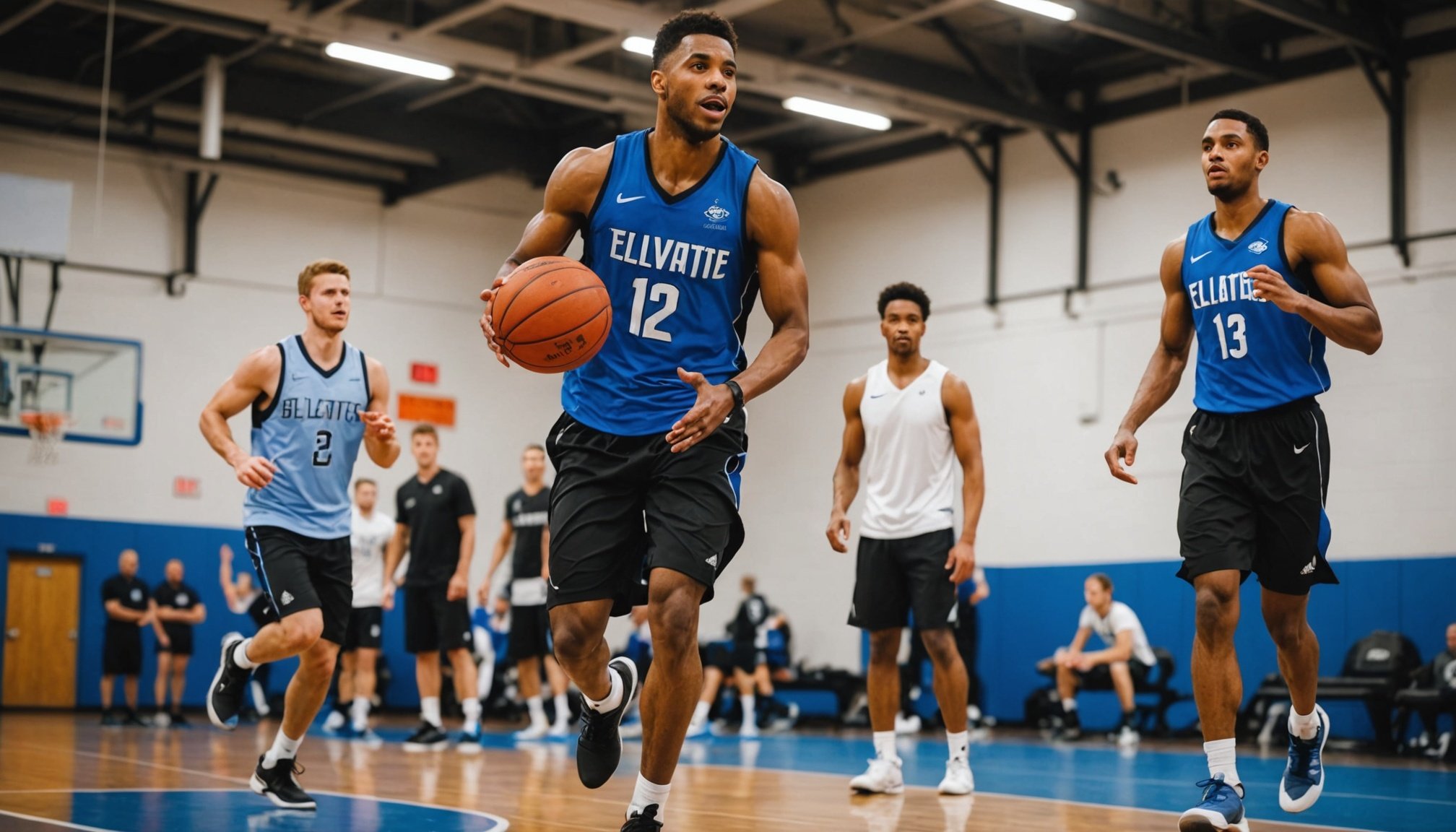Importance of Cardiovascular Fitness for Basketball Players
Cardiovascular fitness is paramount for any serious basketball player aiming to enhance their game. In a sport characterised by quick bursts of activity, sustained effort, and agility, cardiovascular endurance directly impacts basketball performance. Without robust cardiovascular fitness, players may falter during the fast-paced transitions and high-intensity plays that are typical in basketball games.
Basketball demands unique endurance benefits—such as the ability to sustain high energy levels throughout prolonged game sessions. This endurance ensures players can maintain peak performance from start to finish, executing strategic plays effectively without succumbing to fatigue.
In the same genre : Maximizing Game Performance: Strategies for UK Basketball Teams to Optimize Travel Schedules
Long-term, improving cardiovascular fitness not only benefits a player’s immediate basketball performance but also supports their overall health and career longevity. With strong cardiovascular health, players reduce the risk of heart diseases and other related conditions, potentially prolonging their professional lifespan. Thus, integrating cardiovascular fitness into training routines is crucial for both short-term game performance and long-term athlete well-being. This cultivation of endurance lays a foundation for success on the court and beyond, highlighting its definitive role in a basketball player’s training regime.
Overview of Interval Training
Interval training is a dynamic training method that alternates between periods of high intensity and lower-intensity recovery. Unlike traditional methods that maintain a steady pace, interval training optimises fitness improvement by challenging the body to adapt rapidly. Its principles revolve around short bursts of vigorous activity followed by rest or low-intensity phases, effectively enhancing cardiovascular capacity. This approach mimics the unpredictable pace of basketball, where players sprint down the court and then pause or move at a slower pace.
Also to see : Maximizing performance potential: the essential role of strength and conditioning in training uk basketball athletes
Incorporating interval sessions into basketball routines can significantly boost basketball performance. The high-intensity nature aids in building endurance, enabling athletes to sustain effort throughout a game. Moreover, these sessions are tailored to meet sport-specific needs, addressing the agility and speed required on the court.
Interval training is not just beneficial for improving fitness metrics but also adds variety to training, making workouts more engaging for athletes. By introducing movements that replicate game scenarios, players can enhance their adaptability and readiness during matches. Overall, integrating this training method is essential for basketball players aiming to elevate their performance and maintain their competitive edge.
Effective Interval Training Techniques for Basketball
Interval training can significantly enhance a basketball player’s fitness by emphasizing sport-specific training. This methodology adapts to the explosive nature of basketball, preparing athletes for game scenarios.
On-Court Interval Drills
Basketball drills that incorporate intensive bursts, like sprinting and agility exercises, are crucial. High-intensity drills mimic on-court action, sharpening players’ responsiveness and stamina. Employing game-like simulations helps develop a player’s ability to handle quick transitions and strategic plays during matches.
Off-Court Interval Training
In addition to court workouts, off-court interval training is vital. Gym sessions with a mix of bodyweight exercises and resistance training enhance strength and endurance. Cardio circuits focusing on different movement patterns aid in boosting cardiovascular fitness, crucial for sustaining energy in games.
Sample Weekly Interval Training Plan
A structured interval workout plan should be integrated into a player’s routine for balanced development. Tailoring intensity and duration based on individual capabilities is essential. For optimal results, maintain a frequency that complements game schedules, ensuring recovery while continually pushing fitness boundaries.
Nutrition and Recovery Strategies
For optimal basketball performance, nutrition and recovery strategies are pivotal. Proper nutrition for athletes supports the rigorous demands of interval training, ensuring athletes have the energy required for intense workouts and essential recovery periods.
Key nutrients include carbohydrates for energy, proteins for muscle repair, and healthy fats for sustained energy release. Hydration strategies are equally important. Basketball players need to maintain fluid levels before, during, and after training sessions to prevent dehydration. This includes replenishing electrolytes lost through sweat.
Recovery is where the growth happens, both in fitness and skill development. Recovery techniques such as stretching, foam rolling, and adequate rest are critical in combating fatigue and preventing injuries. Taking time for active recovery, such as light jogging or swimming, can aid in muscle relaxation and repair.
Incorporating these strategies enriches the benefits of interval training, ensuring that players can push their limits while maintaining overall health. Implementing a balanced nutrition and recovery plan enhances an athlete’s ability to perform consistently at high levels, contributing to successful sports careers and longevity.
Tracking Performance Metrics
Understanding and analysing performance metrics is crucial for basketball players striving to enhance their fitness levels. Measuring key fitness metrics helps in evaluating the effectiveness of training sessions and guiding future improvements.
Key Metrics for Basketball Players
For basketball players, essential metrics include cardiovascular endurance and agility. Tools like heart rate monitors and GPS trackers provide valuable data, offering insights into a player’s cardiovascular status during workouts and games. These tools help set realistic benchmarks and goals, allowing athletes to track their progress over time.
Analyzing Progress Over Time
Utilising data from performance tracking can significantly improve training strategies. By adjusting the intensity and duration of workouts based on collected metrics, players can address specific areas of weakness. The correlation between maintained fitness levels and improved game performance is evident in the success stories of athletes who diligently track their progress. Meticulous tracking not only enhances fitness improvement but also directly contributes to sustained basketball success.
Integrating Interval Training into Routine
Successfully integrating interval training into a basketball routine can elevate a player’s performance by ensuring they make the most of high-intensity sessions while balancing skill development. Seamless incorporation of interval workouts involves creating a structured schedule that aligns with basketball practice and team drills. Key to this is emphasising efficiency—optimising time spent on fitness without overshadowing essential skill work.
An effective strategy starts with assessing current practice sessions and identifying breaks or warm-up periods suitable for interval routines. Aligning these within practice ensures consistent training integration while maintaining focus on core skills. Coaches can aid by scheduling shorter, intense workouts at the beginning or end of team practices, leveraging warmed-up muscles and high energy levels.
Balance is vital; overloading players with excessive workouts can lead to burnout. Motivating players through varied routines and setting achievable goals fosters long-term commitment. Incorporating fun elements, like competitive drills or team challenges, helps maintain consistency in training. By cleverly integrating intervals into a regular schedule, players can improve not only fitness but also their overall on-court performance.
Expert Insights and Testimonials
Gaining insights from expert recommendations and real-life player testimonials can be invaluable for basketball players seeking to enhance fitness. Coaches and fitness experts highlight the importance of tailored programs that focus on the unique demands of basketball, accentuating on-court agility and cardiovascular robustness. Many advise beginning with gradual intensity in interval routines, progressively increasing the intensity to prevent injury and ensure consistent growth.
Real-life success stories of UK basketball players who have embraced these strategies underscore their efficacy. Players frequently share how structured interval training and disciplined nutrition for athletes significantly improved their strength and stamina, directly correlating to better on-court performance. Tales of athletes who overcame plateaus by reassessing their training schedules and incorporating diversified workouts not only inspire but also provide actionable tips.
For beginners, experts caution against common pitfalls such as neglect of recovery periods and improper tracking of fitness metrics. Players are urged to focus on consistent progress, prioritising holistic training over immediate gains. Such insights can play a crucial role in crafting effective, sustainable training routines that elevate both performance and enthusiasm.











